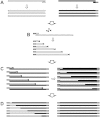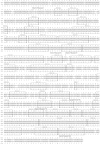In vitro template-change PCR to create single crossover libraries: a case study with B. thuringiensis Cry2A toxins
- PMID: 27097519
- PMCID: PMC4838838
- DOI: 10.1038/srep23536
In vitro template-change PCR to create single crossover libraries: a case study with B. thuringiensis Cry2A toxins
Abstract
During evolution the creation of single crossover chimeras between duplicated paralogous genes is a known process for increasing diversity. Comparing the properties of homologously recombined chimeras with one or two crossovers is also an efficient strategy for analyzing relationships between sequence variation and function. However, no well-developed in vitro method has been established to create single-crossover libraries. Here we present an in vitro template-change polymerase change reaction that has been developed to enable the production of such libraries. We applied the method to two closely related toxin genes from B. thuringiensis and created chimeras with differing properties that can help us understand how these toxins are able to differentiate between insect species.
Figures



Similar articles
-
Tandem repeats in a new toxin gene from Bacillus thuringiensis and in other cry11-like genes.J Mol Microbiol Biotechnol. 2011;20(4):204-10. doi: 10.1159/000329824. Epub 2011 Jul 19. J Mol Microbiol Biotechnol. 2011. PMID: 21778765
-
Characterization of a cry4Ba-type gene of Bacillus thuringiensis israelensis and evidence of the synergistic larvicidal activity of its encoded protein with Cry2A delta-endotoxin of B. thuringiensis kurstaki on Culex pipiens (common house mosquito).Biotechnol Appl Biochem. 2006 Apr;44(Pt 1):19-25. doi: 10.1042/BA20050134. Biotechnol Appl Biochem. 2006. PMID: 16309381
-
The Bacillus thuringiensis cyt genes for hemolytic endotoxins constitute a gene family.Appl Environ Microbiol. 2001 Mar;67(3):1090-6. doi: 10.1128/AEM.67.3.1090-1096.2001. Appl Environ Microbiol. 2001. PMID: 11229896 Free PMC article.
-
Structure, function and engineering of Bacillus thuringiensis toxins.Genet Eng (N Y). 1995;17:99-117. Genet Eng (N Y). 1995. PMID: 7779517 Review.
-
Regulation of toxin and virulence gene transcription in Bacillus thuringiensis.Int J Med Microbiol. 2000 Oct;290(4-5):295-9. doi: 10.1016/S1438-4221(00)80024-7. Int J Med Microbiol. 2000. PMID: 11111901 Review.
Cited by
-
Modern methods for laboratory diversification of biomolecules.Curr Opin Chem Biol. 2017 Dec;41:50-60. doi: 10.1016/j.cbpa.2017.10.010. Epub 2017 Nov 2. Curr Opin Chem Biol. 2017. PMID: 29096324 Free PMC article. Review.
-
Making 3D-Cry Toxin Mutants: Much More Than a Tool of Understanding Toxins Mechanism of Action.Toxins (Basel). 2020 Sep 16;12(9):600. doi: 10.3390/toxins12090600. Toxins (Basel). 2020. PMID: 32948025 Free PMC article. Review.
-
Toxic Activity, Molecular Modeling and Docking Simulations of Bacillus thuringiensis Cry11 Toxin Variants Obtained via DNA Shuffling.Front Microbiol. 2018 Oct 17;9:2461. doi: 10.3389/fmicb.2018.02461. eCollection 2018. Front Microbiol. 2018. PMID: 30386315 Free PMC article.
References
Publication types
MeSH terms
Substances
LinkOut - more resources
Full Text Sources
Other Literature Sources
Molecular Biology Databases

